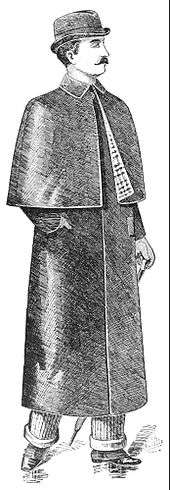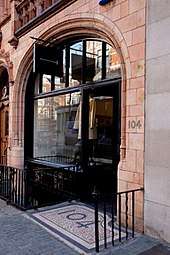Mackintosh
The Mackintosh or raincoat (abbreviated as mac) is a form of waterproof raincoat, first sold in 1824, made out of rubberised fabric.[2]
| Subsidiary | |
| Industry | Textile industry |
| Founded | Glasgow, 1846s |
| Headquarters | Cumbernauld, Scotland |
Key people | Charles Macintosh, Founder |
| Products | Rubberised coats and accessories |
| Owner | Yagi Tsusho[1] |
| Website | mackintosh |
The Mackintosh is named after its Scottish inventor Charles Macintosh, although many writers added a letter k. The variant spelling of "Mackintosh" is now standard.[3]
Although the Mackintosh coat style has become generic, a genuine Mackintosh coat is made from rubberised or rubber laminated material.
History

It has been claimed that the material was invented by the surgeon James Syme, but then copied and patented by Charles Macintosh;[4] Syme's method of creating the solvent from coal tar was published in Thomson's Annals of Philosophy in 1818;[5] this paper also describes the dissolution of natural rubber in naphtha.
However, an exhaustive history of the invention of the Mackintosh was published by Schurer in 1952.[6] The essence of Macintosh's process was the sandwiching of an impermeable layer of a solution of rubber in naphtha (derived from tar) between two layers of fabric. Syme did not propose the sandwich idea and his paper did not mention waterproofing. Waterproofing garments with rubber was an old idea, and was practised in pre-Columbian times by Aztecs, who impregnated fabric with latex. Later, French scientists made balloons gas-tight (and incidentally, impermeable) by impregnating fabric with rubber dissolved in turpentine, but this solvent was not satisfactory for making apparel.
In 1830 Macintosh's company merged with the clothing company of Thomas Hancock in Manchester. Hancock had also been experimenting with rubber coated fabrics since 1819. Production of rubberised coats soon spread all over the UK. Every kind of coat was produced with rubberized material including riding coats and coats supplied to the British Army, British railways, and UK police forces.
Early coats had problems with smell, stiffness, and a tendency to melt in hot weather, but Hancock further improved his waterproof fabrics, patenting a method for vulcanising rubber in 1843 which solved many of the problems.[7]

Throughout the 19th and 20th centuries, the company continued to make waterproof clothing. In 1925 the company was taken over by Dunlop Rubber.[8]
Revival
In the mid-1990s the Mackintosh brand owner, Traditional Weatherwear, was on the verge of closing its factory in Blairlinn, Cumbernauld near Glasgow.[9] Around the turn of the 21st century, senior staff members acquired the company and established the traditional rubberised Mackintosh coat as an upmarket brand in its own right. The company collaborated with leading fashion houses such as Gucci, Hermès, Louis Vuitton, and Liberty. The coats became particularly popular with Japanese women, and the company won a Queen's Award for Enterprise in 2000 for its success in international trade.[10] In December 2003 the company name was formally changed to Mackintosh.
In 2007, Mackintosh was bought by Tokyo firm Yagi Tsusho.[1] With the backing of its parent company Mackintosh has continued to expand its reputation and marketing operations. In January 2011, the company opened its first fashion store in London.[11]
In 2017, Mackintosh expanded to include a premium fashion-oriented line headed by Bulgarian designer Kiko Kostadinov, titled Mackintosh 0001. These new lines of fashion both included male and female lines of clothing.
References
- "The rebirth of the Mackintosh fashion label". The Scotsman. 2011-02-08. Retrieved 2013-11-06.
- "Mrs Mac is back". The Scotsman. 2002-10-03. Archived from the original on 2007-10-30. Retrieved 2013-11-06.
- Shorter Oxford English Dictionary, 6th ed. (2008)p. 1668
- "Whonamedit – James Syme". Whonamedit. Retrieved 23 August 2013.
- Thomson, T., Phillips, R., & Brayley, E. (1818). Article V: on a substance from coal tar. Annals Of Philosophy, XII, 112–113
- "The Macintosh: The Paternity of an Invention". Transactions of the Newcomen Society, 28(1), pp. 77–87
- "Return of the Mac: The reinvention of Mackintosh". The Independent. 2007-10-08. Retrieved 2013-11-06.
- "The Queen's Awards for Enterprise". Queensawards.org.uk. 2013-09-30. Archived from the original on 2008-05-12. Retrieved 2013-11-06.
- "Mackintosh opens first fashion store in London". BBC News. 2011-01-21. Retrieved 2013-11-06.
Bibliography
- Hancock, Thomas (1857). Personal Narrative of the Origin and Progress of the Caoutchouc or India-Rubber Manufacture in England. London: Longman, Brown, Green, Longmans & Roberts.
- Schurer, H. (1951–53). "The Macintosh: the paternity of an invention". Transactions of the Newcomen Society. 28: 77–87.
External links
| Wikimedia Commons has media related to Mackintosh. |